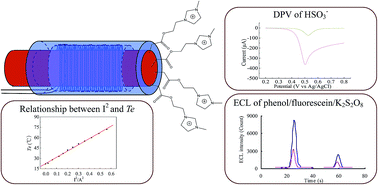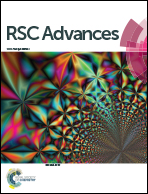Fabrication of a heated electrode modified with a thiol-functionalized ionic liquid for electrochemical/electrochemiluminescence sensors†
Abstract
A new heated thiol-functionalized ionic liquid (TFIL)/Au composite electrode, which possessed the advantages of a heated electrode technique and ionic liquids (ILs), was designed and fabricated in this study. The electrode temperature (Te) could be accurately controlled by indirect electrical heating. Attributed to the stable Au–S bone and the very low vapor pressure of IL, the immobilized TFIL was stable on the electrode at high Te. The heated TFIL/Au electrode could be expediently used to study the electrochemical behavior of thermally unstable material at high temperature. The analytical performances of electrochemical (EC)/electrochemiluminescence (ECL) detection systems based on the heated TFIL/Au electrodes were evaluated by HSO3− and phenol, respectively. Higher electron-transfer rates, enhanced sensitivities, and improved reproducibilities were obtained compared with the bare Au electrode. The heated TFIL/Au composite electrode presented a promising platform for EC or ECL sensors.

- This article is part of the themed collection: Nanoscience and nanotechnology in electrochemistry

 Please wait while we load your content...
Please wait while we load your content...